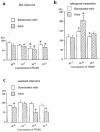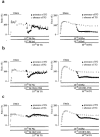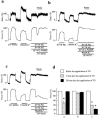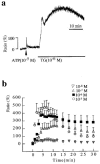Thapsigargin-induced endothelium-dependent triphasic regulation of vascular tone in the porcine renal artery
- PMID: 10516650
- PMCID: PMC1571664
- DOI: 10.1038/sj.bjp.0702821
Thapsigargin-induced endothelium-dependent triphasic regulation of vascular tone in the porcine renal artery
Abstract
1. To elucidate the role of thapsigargin-induced Ca2+ entry in endothelial cells in the regulation of vascular tone, changes in Ca2+ and force of smooth muscle were simultaneously monitored in fura-2-loaded strips of porcine renal artery. 2. During phenylephrine-induced sustained contraction, thapsigargin caused an endothelium-dependent triphasic response; an initial relaxation, a subsequent transient contraction, and a sustained relaxation. The initial relaxation and the contraction were associated with a decrease and an increase in [Ca2+]i, respectively. There was no apparent [Ca2+]i decrease during the sustained relaxation. Thapsigargin-induced responses were observed at 10-8 M and higher concentrations, with the maximum response observed at 10-6 M. 3. The transient contraction was inhibited by a cyclo-oxygenase inhibitor (10-5 M indomethacin), a thromboxane A2 (TXA2)/prostaglandin H2 (PGH2) receptor antagonist (10-5 M ONO-3708), and a TXA2 synthase inhibitor (10-5 M OKY-046). 4. During the phenylephrine-induced contraction in the presence of indomethacin, thapsigargin caused an initial, but not a sustained relaxation, in the presence of Nomega-nitro-L-arginine methylester (L-NAME). During the contraction induced by phenylephrine plus 40 mM K+-depolarization in the presence of indomethacin, thapsigargin induced both a transient and a sustained relaxation. However, these relaxations were completely abolished in the presence of L-NAME. 5. Thapsigargin caused a large Ca2+ elevation in cultured endothelial cells of the renal artery. The concentration-response relation was thus similar to that for force development in the arterial strips. 6. In conclusion, thapsigargin-induced Ca2+ entry in endothelial cells led to triphasic changes in the tone of the porcine renal artery. The endothelium-dependent contraction was mediated mainly by TXA2. Nitric oxide and hyperpolarizing factor are both involved in the initial relaxation. However, a sustained relaxation was observed which mainly depended on nitric oxide.
Figures






Similar articles
-
Thrombin causes endothelium-dependent biphasic regulation of vascular tone in the porcine renal interlobar artery.Br J Pharmacol. 2000 Dec;131(8):1635-42. doi: 10.1038/sj.bjp.0703737. Br J Pharmacol. 2000. PMID: 11139441 Free PMC article.
-
The mechanism of bradykinin-induced endothelium-dependent contraction and relaxation in the porcine interlobar renal artery.Br J Pharmacol. 2000 Mar;129(5):943-52. doi: 10.1038/sj.bjp.0703141. Br J Pharmacol. 2000. PMID: 10696094 Free PMC article.
-
Mechanisms of the thapsigargin-induced Ca(2+) entry in in situ endothelial cells of the porcine aortic valve and the endothelium-dependent relaxation in the porcine coronary artery.Br J Pharmacol. 2000 Sep;131(1):115-23. doi: 10.1038/sj.bjp.0703548. Br J Pharmacol. 2000. PMID: 10960077 Free PMC article.
-
Dual regulation of cerebrovascular tone by UTP: P2U receptor-mediated contraction and endothelium-dependent relaxation.Br J Pharmacol. 1996 Jun;118(4):847-56. doi: 10.1111/j.1476-5381.1996.tb15477.x. Br J Pharmacol. 1996. PMID: 8799553 Free PMC article.
-
Gender differences in the regulation of vascular tone.Clin Exp Pharmacol Physiol. 2003 Jan-Feb;30(1-2):1-15. doi: 10.1046/j.1440-1681.2003.03790.x. Clin Exp Pharmacol Physiol. 2003. PMID: 12542447 Review.
Cited by
-
Interleukin 10 knockout frail mice develop cardiac and vascular dysfunction with increased age.Exp Gerontol. 2013 Feb;48(2):128-35. doi: 10.1016/j.exger.2012.11.001. Epub 2012 Nov 13. Exp Gerontol. 2013. PMID: 23159957 Free PMC article.
-
Role of E-type prostaglandin receptor EP3 in the vasoconstrictor activity evoked by prostacyclin in thromboxane-prostanoid receptor deficient mice.Sci Rep. 2017 Feb 6;7:42167. doi: 10.1038/srep42167. Sci Rep. 2017. PMID: 28165064 Free PMC article.
-
The role of RhoA/Rho kinase pathway in endothelial dysfunction.J Cardiovasc Dis Res. 2010 Oct;1(4):165-70. doi: 10.4103/0975-3583.74258. J Cardiovasc Dis Res. 2010. PMID: 21264179 Free PMC article.
-
Thrombin causes endothelium-dependent biphasic regulation of vascular tone in the porcine renal interlobar artery.Br J Pharmacol. 2000 Dec;131(8):1635-42. doi: 10.1038/sj.bjp.0703737. Br J Pharmacol. 2000. PMID: 11139441 Free PMC article.
-
Ca(2+) influx in the endothelial cells is required for the bradykinin-induced endothelium-dependent contraction in the porcine interlobar renal artery.J Physiol. 2001 Aug 1;534(Pt 3):701-11. doi: 10.1111/j.1469-7793.2001.t01-1-00701.x. J Physiol. 2001. PMID: 11483701 Free PMC article.
References
-
- AUKLAND K. Myogenic mechanisms in the kidney. J. Hypertens. 1989;7:S71–S77. - PubMed
-
- BERTHON B., BINET A., MAUGER J.P., CLARET M. Cytosolic free Ca2+ in isolated rat hepatocytes as measured by quin2. Effects of noradrenaline and vasopressin. FEBS Lett. 1984;167:19–24. - PubMed
-
- BOULANGER C.M., VANHOUTTE P.M. Interleukin-2 causes endothelium-dependent contractions to arachidonic acid. Hypertension. 1993;21:289–293. - PubMed
Publication types
MeSH terms
Substances
LinkOut - more resources
Full Text Sources
Miscellaneous

